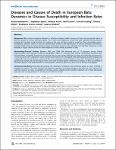Diseases and causes of death in European bats: dynamics in disease susceptibility and infection rates.
Mühldorfer, Kristin
Speck, Stephanie
Kurth, Andreas
Lesnik, René
Freuling, Conrad
Müller, Thomas
Kramer-Schadt, Stephanie
Wibbelt, Gudrun
Background: Bats receive increasing attention in infectious disease studies, because of their well recognized status as reservoir species for various infectious agents. This is even more important, as bats with their capability of long distance dispersal and complex social structures are unique in the way microbes could be spread by these mammalian species. Nevertheless, infection studies in bats are predominantly limited to the identification of specific pathogens presenting a potential health threat to humans. But the impact of infectious agents on the individual host and their importance on bat mortality is largely unknown and has been neglected in most studies published to date. Methodology/Principal Findings: Between 2002 and 2009, 486 deceased bats of 19 European species (family Vespertilionidae) were collected in different geographic regions in Germany. Most animals represented individual cases that have been incidentally found close to roosting sites or near human habitation in urban and urban-like environments. The bat carcasses were subjected to a post-mortem examination and investigated histo-pathologically, bacteriologically and virologically. Trauma and disease represented the most important causes of death in these bats. Comparative analysis of pathological findings and microbiological results show that microbial agents indeed have an impact on bats succumbing to infectious diseases, with fatal bacterial, viral and parasitic infections found in at least 12% of the bats investigated. Conclusions/Significance: Our data demonstrate the importance of diseases and infectious agents as cause of death in European bat species. The clear seasonal and individual variations in disease prevalence and infection rates indicate that maternity colonies are more susceptible to infectious agents, underlining the possible important role of host physiology, immunity and roosting behavior as risk factors for infection of bats.
Dateien zu dieser Publikation
Keine Lizenzangabe
Verwandte Publikationen
Anzeige der Publikationen mit ähnlichem Titel, Autor, Urheber und Thema.
-
2013-06-06ZeitschriftenartikelTravel-associated Legionnaires’ disease in Europe, 2010 Jong, B. de; Hallström, L. Payne; Robesyn, E.; Ursut, D.; Zucs, PhillipIn 2010, the European surveillance network for travel-associated Legionnaires’ disease (ELDSNet, previously EWGLINET) received reports of 864 cases of travel-associated Legionnaires’ disease, of whom 24 were reported to ...
-
2013-02-19ZeitschriftenartikelLymphogranuloma Venereum in Men Screened for Pharyngeal and Rectal Infection, Germany Haar, Karin; Dudareva-Vizule, Sandra; Wisplinghoff, Hilmar; Wisplinghoff, Fabian; Sailer, Andrea; Jansen, Klaus; Henrich, Birgit; Marcus, UlrichTo determine prevalence of lymphogranuloma venereum among men who have sex with men in Germany, we conducted a multicenter study during 2009–2010 and found high rates of rectal and pharyngeal infection in men positive for ...
-
2009-10-15ZeitschriftenartikelLow ankle-brachial index predicts cardiovascular risk after acute ischemic stroke or transient ischemic attack Busch, Markus; Lutz, Katrin; Röhl, Jens-Eric; Neuner, Bruno; Masuhr, FlorianBackground and purpose: A low ankle-brachial blood pressure index (ABI) is an established risk marker for cardiovascular disease and mortality in the general population, but little is known about its prognostic value in ...

